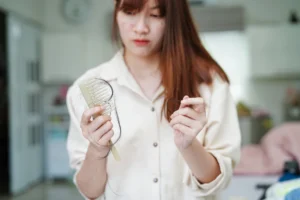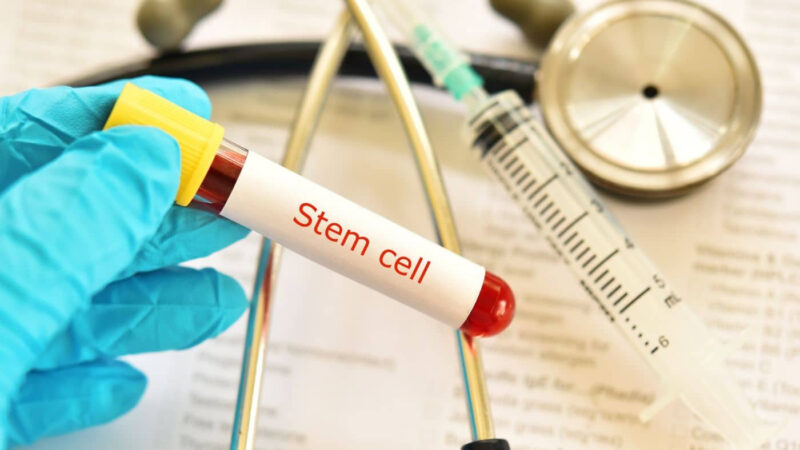What Is Microneedling for Hair Loss?
Microneedling for hair loss, also known as microneedle therapy or microneedle roller treatment, involves the use of tiny needles to create micro-injuries on the scalp. This technique is performed similarly to how micro-needling is done for skin problems, where a trained practitioner utilizes specialized tools such as skin rollers or derma rollers to create these minuscule punctures in the skin.
The purpose of these microscopic cuts on the scalp is to stimulate the natural healing response of the body. The micro-injuries trigger the production of collagen and elastin in the scalp, which are essential proteins for hair growth and overall skin health. Additionally, the microchannels created during the microneedling process facilitate better absorption of topical treatments and serums, enhancing their effectiveness in promoting hair regrowth.

The stimulation of collagen and elastin helps improve blood circulation in the scalp, delivering essential nutrients and oxygen to the hair follicles. This, in turn, encourages the revitalization of weakened or dormant hair follicles, promoting hair regrowth and reducing hair thinning or loss.
Microneedling for hair loss is a minimally invasive procedure that is generally well-tolerated by most individuals. It’s crucial to consult with a qualified healthcare professional or a licensed dermatologist before undergoing this treatment to ensure it’s appropriate for your specific condition and to determine the most suitable approach for achieving optimal results. Additionally, following post-treatment care and a consistent treatment schedule can maximize the potential benefits of microneedling for hair loss.
Understanding the Science Behind Microneedling for Hair Restoration
One of the key reasons why microneedling is effective in combating hair loss is its ability to stimulate the WNT-pathway. This pathway, which begins to decline in men as early as 24 years of age, plays a crucial role in cell-to-cell communication, facilitating nutrient transmission and manufacturing between cells. As this pathway shrinks, it limits the signals between cells, leading to a reduced supply chain of vital nutrients. Microneedling can help expand the WNT-Pathway, thereby reestablishing the connection between cellular powerhouses and receptors. This treatment can be performed as a standalone procedure or in combination with medications and regenerative therapies.
Microneedling vs. Similar Treatments
Microneedling is not the only treatment option available for skin and hair concerns. Similar therapies include derma rolling and derma pen with radiofrequency. Microneedling involves stamping the skin with needles, while derma rolling uses a rolling motion on the treatment area. The derma pen, on the other hand, is an electronic device that can come in a roller format. Radiofrequency needles, often longer than those used in traditional microneedling, stimulate collagen and elastin production, although they may result in more significant discomfort. It’s important to note that not all electronic microneedling devices penetrate deep enough to produce a substantial effect.
Microneedling for Medication Delivery
Microneedling can also be employed to enhance the delivery of topical medications such as finasteride, dutasteride, minoxidil, spironolactone, latisse, and latanoprost. By creating micro-wounds in the skin, microneedling enables deeper penetration of these medications, thereby increasing their effectiveness. However, it’s crucial to be aware that combining microneedling with medications may raise the risk of systemic side effects due to enhanced absorption into the bloodstream.

Timing and Application of Medications
Some medical therapies, like minoxidil, should not be applied immediately after microneedling due to the alcohol concentration in the product, which can cause a burning sensation. It is often advisable to wait until the following day to apply minoxidil. The timing and application of medical therapies should be determined based on the active ingredients in your specific treatment.
Combining Microneedling with PRP/CRP
Combining microneedling with platelet-rich plasma (PRP) or cell-rich plasma (CRP) treatments represents a synergistic approach in the field of hair loss therapy, offering potentially enhanced and more promising results. Both PRP and CRP are techniques that harness the regenerative power of the body’s own platelets or cells to promote healing and tissue rejuvenation.

Platelet-rich plasma (PRP) treatment comprises drawing a patient’s blood, isolating the platelets abundant in growth factors through processing, and subsequently administering this concentrated plasma directly into the scalp to promote the stimulation of hair. Similarly, CRP employs cells from the patient’s own body, such as adipose-derived stem cells, to foster tissue regeneration and activate the follicles.
When microneedling is introduced to this equation, it acts as a complementing catalyst. Microneedling creates micro-injuries on the scalp, which not only stimulate the production of collagen and elastin but also enhance the absorption and distribution of the growth factors released during PRP or CRP treatments. These growth factors, including platelet-derived growth factor (PDGF), transforming growth factor-beta (TGF-β), and insulin-like growth factor (IGF), play a critical role in stimulating and encouraging new hair growth.
Microneedling, acting as a monotherapy, already triggers a localized inflammatory response and subsequent release of growth factors within the scalp. By combining this process with PRP or CRP treatments, the cumulative effect is intensified, generating a more robust and targeted stimulation of new hair growth. This synergistic approach maximizes the potential for hair regrowth and can be particularly beneficial for individuals experiencing various degrees of hair thinning or hair loss.
It’s essential to note that the success of these combined treatments may vary from person to person, and consultation with a healthcare professional or dermatologist is vital to determine the most appropriate and effective treatment plan based on individual circumstances and goals.
Optimal Procedure Sequence
When incorporating microneedling with regenerative treatments, it is generally recommended to inject the regenerative therapy first, followed by microneedling or derma rolling. The microneedling process involves stamping the treated area, while derma rolling follows a rolling technique. Individuals with long hair who choose to derma roll are advised to stamp the area to minimize hair pulling and breakage.
Microneedling’s Effect on Hair Growth
Research and test studies on mice have shown that microneedling can promote hair regrowth. In human subjects, microneedling has demonstrated an improvement in hair follicle diameter, as observed through dermoscopy or scalp magnification. However, it is important to note that microneedling and similar treatments typically do not significantly increase hair density or the number of hairs per follicular unit.
Choosing the Right Needle Depth
Microneedling needles come in various sizes, ranging from 0.6mm to 2.5mm. The choice of needle depth depends on the desired treatment and the area being targeted. Deeper needling may require disinfection of the area before treatment, which can be achieved using a betadine solution or aseptic spray. Longer needles can result in more significant wounds and discomfort. After microneedling, it is advisable to wait at least six hours before washing your hair.
Optimal Needle Depth for Microneedling
Clinical studies have indicated that the optimal needle depth for microneedling is typically 1.5mm. This depth allows the needles to penetrate the dermis, accessing a greater supply of blood capillaries, which triggers a potent inflammatory response. However, it’s important to note that not everyone has the same pain tolerance for a 1.5mm depth needle. For individuals who find this depth uncomfortable, results can still be achieved with a shallower needle (e.g., 0.6mm), but the frequency of passes may need to be increased.
Determining the Frequency of Microneedling
Microneedling should not be performed too frequently, as it carries the risk of scarring and can limit blood circulation to the treated area, leading to hair shedding. A recommended frequency is once per month, using a 1.5mm depth needle. Consulting with a physician is crucial to determine the ideal frequency and number of passes based on your specific needs.
Potential Side Effects
Like any cosmetic procedure, microneedling comes with potential side effects. These may include itchiness due to the open wounds, redness resulting from the inflammatory response, hair shedding (as the treatment stimulates hair from telogen to anagen), risk of infection due to the open wounds, and the possibility of scarring.
Microneedling for Different Types of Alopecia
Microneedling has emerged as a promising therapeutic option for addressing different types of alopecia, demonstrating its potential to stimulate hair growth and improve the condition of the scalp across various forms of hair loss. Its effectiveness has been particularly noteworthy in treating androgenetic alopecia, alopecia areata, and telogen effluvium.
1. Androgenetic Alopecia (AGA):
Androgenetic alopecia, commonly known as male-pattern baldness or female-pattern baldness, is often associated with the hormone DHT (dihydrotestosterone). DHT can shrink hair follicles, leading to thinning of the hair and eventual hair loss. Microneedling has shown promising results in individuals with androgenetic alopecia by stimulating the production of collagen and growth factors in the scalp. These processes help to rejuvenate and strengthen the follicles, potentially counteracting the effects of DHT and promoting hair growth.
2. Alopecia Areata:
Alopecia areata is an autoimmune disorder characterized by the sudden loss of hair in small, round patches on the scalp or other parts of the body. Microneedling has demonstrated effectiveness in treating alopecia areata by inducing a controlled inflammatory response and triggering the release of growth factors. This process helps regenerate the affected area and promotes hair regrowth within the patches of missing hair.
3. Telogen Effluvium:
Telogen effluvium is a type of hair loss characterized by excessive shedding of hair due to a disruption in the hair growth cycle. It is often triggered by stress, illness, hormonal changes, or nutritional deficiencies. Microneedling can be beneficial in cases of telogen effluvium by promoting a healthier scalp environment through the stimulation of collagen and improved blood circulation. This can help reduce hair shedding and encourage the transition from the resting (telogen) phase to the growth (anagen) phase.
In each of these cases, microneedling helps by creating microscopic punctures in the scalp, prompting a healing response that involves the production of collagen, elastin, and growth factors. These factors facilitate the repair and rejuvenation of hair follicles, which can lead to improved hair density and overall hair health.
It’s essential to consult with a healthcare professional or a licensed dermatologist to determine the suitability of microneedling for a specific type of alopecia and to develop a personalized treatment plan for optimal results.
Summary

Microneedling treatment has emerged as a versatile and effective cosmetic procedure with applications in hair restoration, skin rejuvenation, and to improve acne scars. Its ability to stimulate the WNT-Pathway, enhance medication delivery, and boost the effectiveness of regenerative therapies makes it a valuable tool in the field of aesthetics and dermatology. However, it’s essential to approach microneedling with caution, considering factors such as needle depth, frequency, and potential side effects. Consulting with a qualified healthcare provider is key to achieving optimal results and ensuring a safe and successful microneedling experience.
Frequently Asked Questions
Does microneedling work to help promote hair growth?
Use of Dermarollers as an effective scalp treatment for hair loss. In a 2021 research study, Microneedling may help to increase thinning hairs than Minoxidil. Minoxidile and microneedling are a more powerful treatment alternative to microneedling alone.
How often should I microneedle my hair?
The bigger the needle, the greater the frequency of sessions. Microneeding for 0.25mm needles is performed once or twice a day. Suitable for improving the effect of Minoxidide & other products on the scalp. Microneedling is done at the needle size of 1.5 cm every 1-2 weeks.
How long do microneedling results last?
Typically, microneedle treatments can last between 3 – 5 months.
How long does it take for microneedling to work for hair loss?
New hair grows at about 6-week intervals within microneedling and at 10-week intervals within minoxidil groups. Hair grew faster than Minoxidil and Microneedlings in Week 1.
Can Dermaroller help regrow hair?
Yes. Derma Roller helps to reduce hair loss except for Telogen effluvium. The tiny cuts that come with the rolling of the scalp activate hair cells promoting growth. It also stimulates collagen production and helps to increase hair growth.
How long does it take for a derma roller to induce new hair growth?
Can you list the time required to remove dead skin? Typically the result is favourable within eight to ten weeks. You have to wait a bit for results, regardless of the effectiveness of derma rollers.








